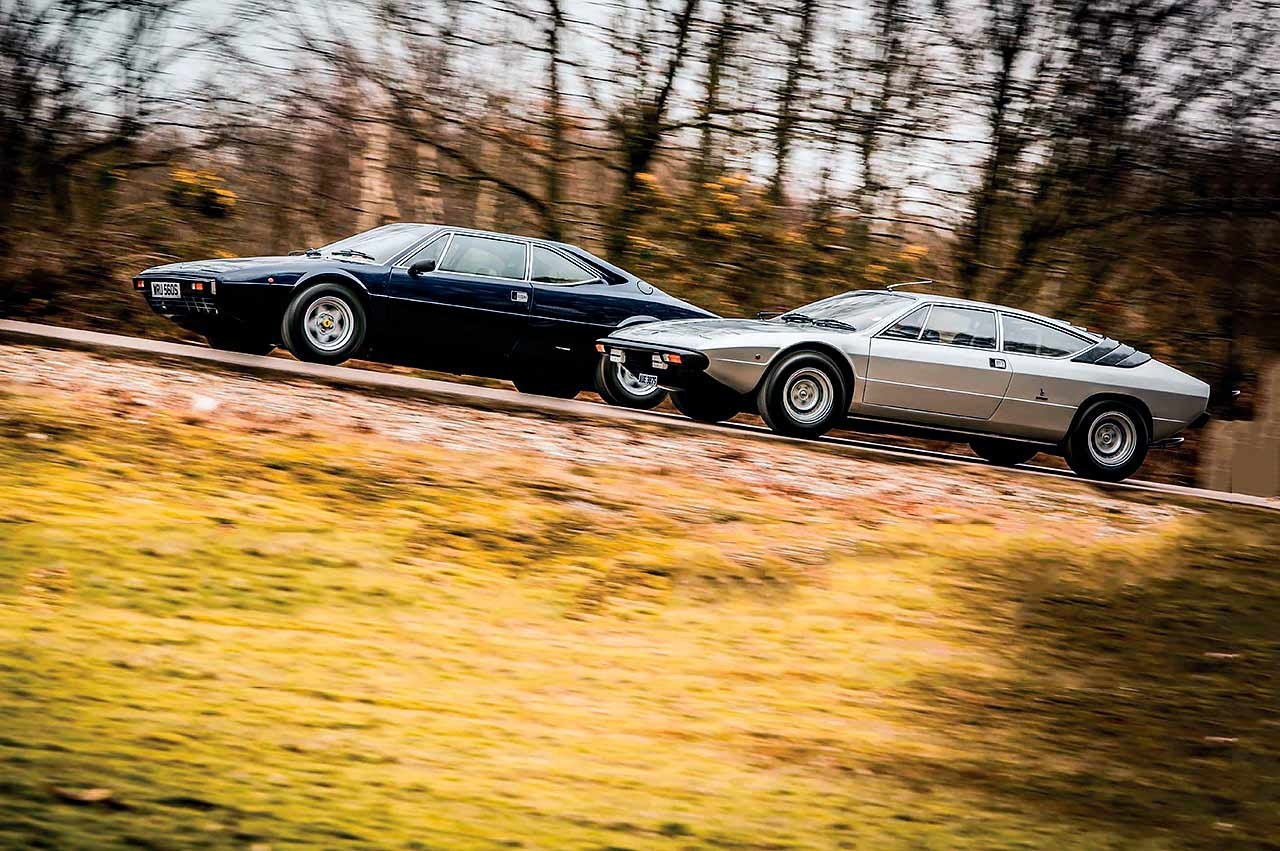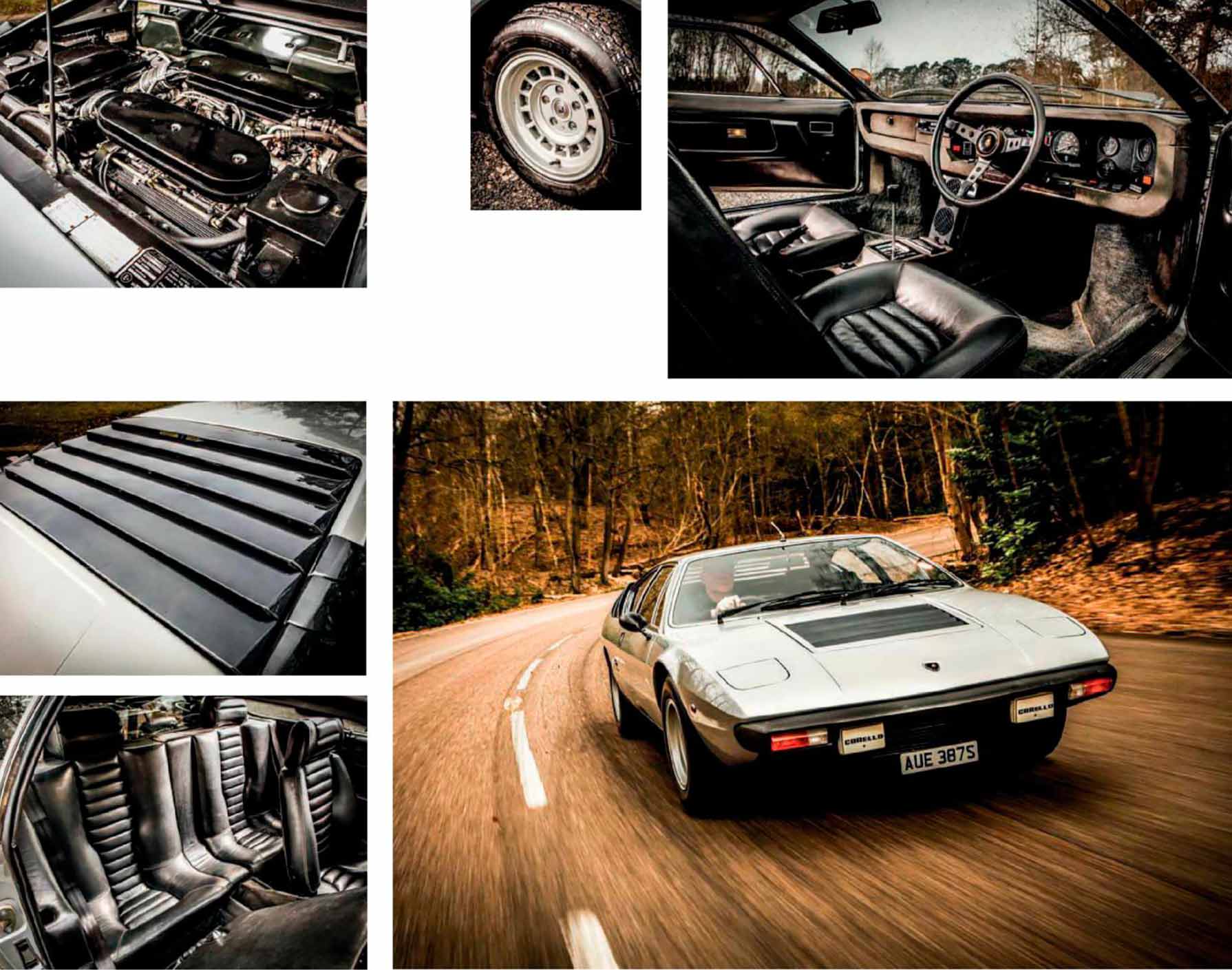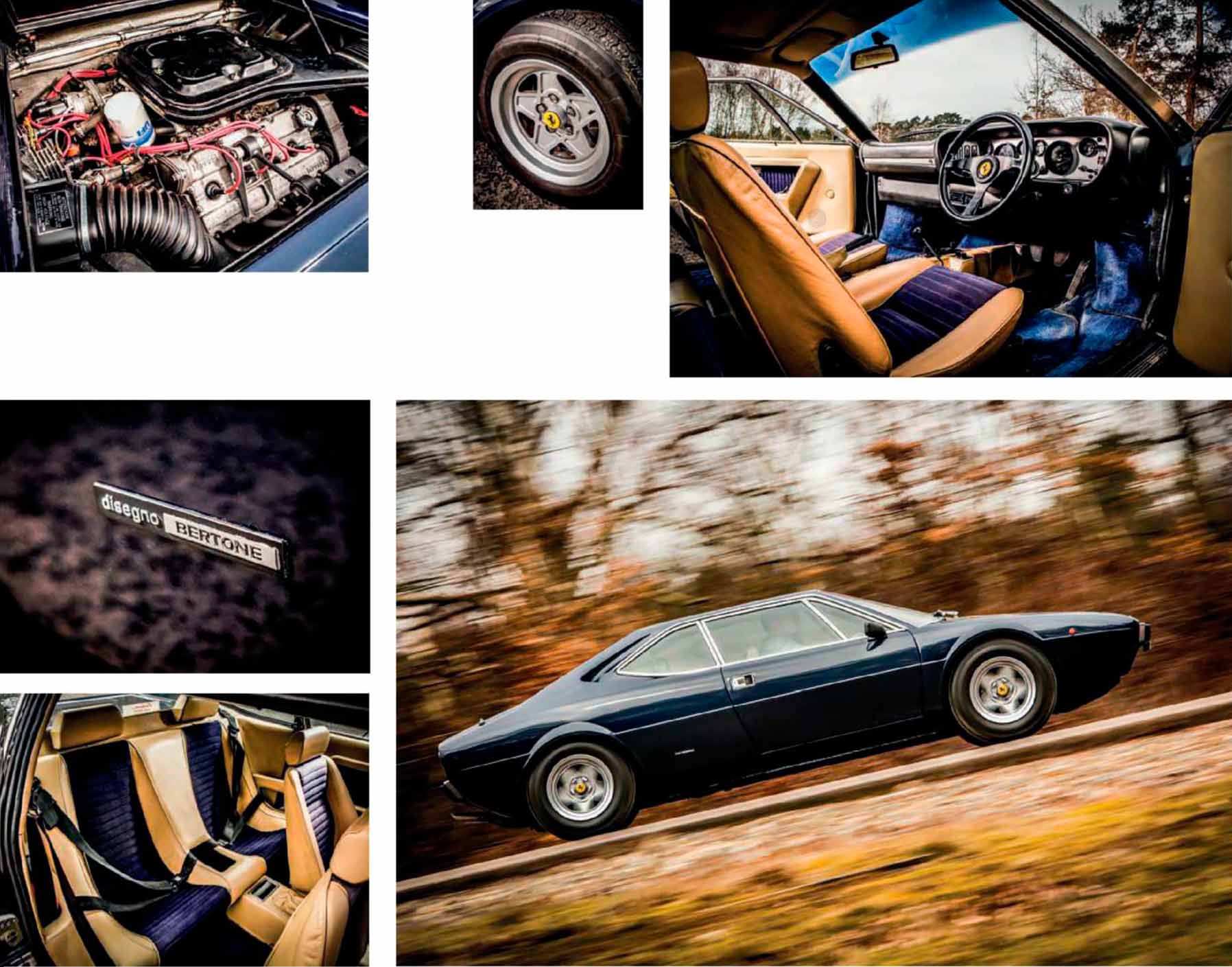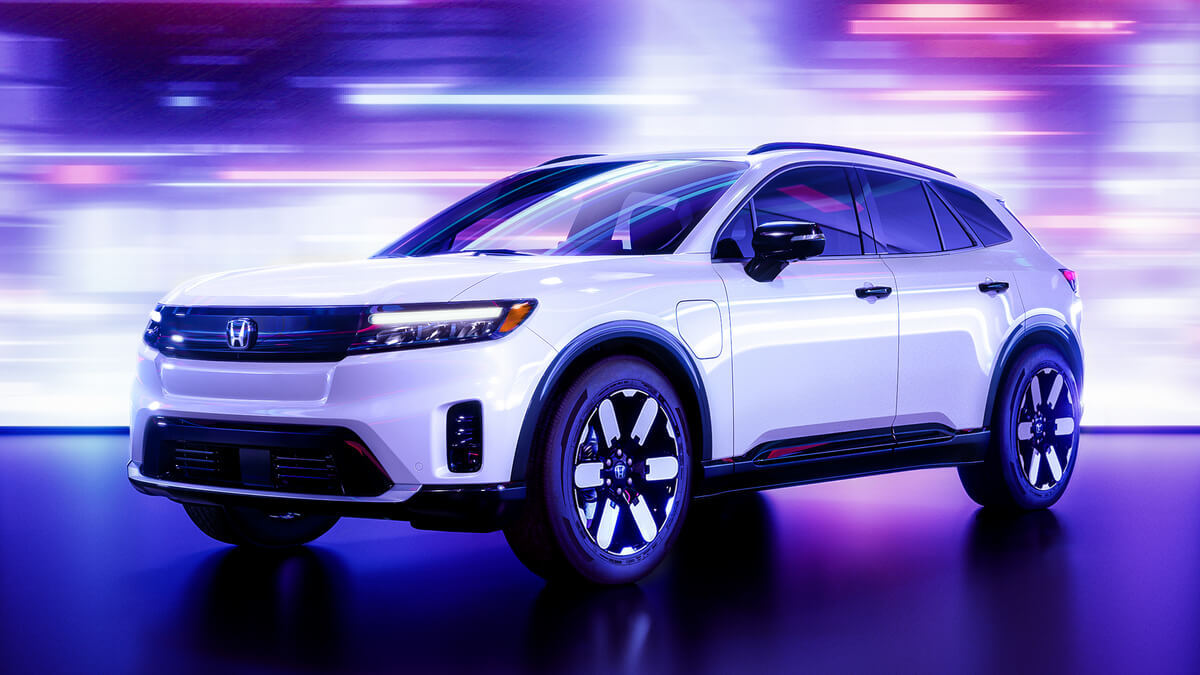
Ferrari vs Lamborghini – can GT4 beat Urraco? Practical performance: 1970s 2+2 V8s from Ferrari and Lamborghini. Ferrari vs. Lamborghini. 308GT4 and Urraco lock horns in a fight for the sensible-supercar crown. Junior Class. With their extra pair of seats and V8 engines, the Ferrari 308GT4 and Lamborghini Urraco were overlooked for decades. Unfairly so, says James Page as he chooses his favourite. Photography Tony Baker.
Much of this is the Porsche 911’s fault. At a time when Italian aristocrat Ferrari and upstart Lamborghini were concentrating on their 12-cylinder models, Stuttgart’s nimble and efficient little sports car was making hay in the class below. Maranello was first to expand into similar territory with the sublime 206 and 246 Dino. Its gorgeous styling and sweet race-derived V6 now place it into the pantheon of greats, even if, at the time, Enzo preferred not to apply his illustrious name to this most junior of Ferraris.

Despite its many obvious and enduring qualities, the Dino was still just a two-seater. Over the course of the next decade, however, many sporting marques would create 2+2s with which to broaden their appeal. At the four-cylinder end of the market, Lotus followed the Elan +2 with the Elite, and Alpine supplemented the A110 with the altogether more grown-up A310.
In 1971, Maserati joined the party with the V6 Merak, but that was a year after Lamborghini had first unveiled the car that would become the Urraco. The work of engineer Paolo Stanzani and Bertone stylist Marcello Gandini, the ‘baby’ Lambo shrunk the bonkers but successful Espada theme and added a mid-engined twist in that it featured vestigial back seats plus an all-new V8 powerplant that, when it was launched, displaced 2463cc.
That show car was very much a handbuilt one-off, though, and it took two years to be turned into a production reality. They were two turbulent years for the company, as well. There was talk of giving Stanzani’s engine a dry-sump system, but that was soon deemed unnecessary. It needed to be mated to a brand-new gearbox, though, which was made in-house and, despite its impressive ability to rev to 9000rpm, it caused serious teething troubles both in testing and once production started.

In 1972, the year in which the first Urraco 250s trickled out of the Sant’Agata factory, Ferruccio sold a controlling stake in his car business to Georges Rossetti. The new boss realised that the resources simply weren’t there to build the model in anything like the numbers – 1000 per year – that had been envisaged. Add regular strikes among the workforce in the Communist heartland of Bologna, the oil crisis and problems getting the car homologated for sale in the vital US market, and it’s a wonder that the Urraco survived long enough to morph into the much-improved P300 in 1974. That was the year in which Ferruccio sold up completely and went to concentrate on his vineyards and golf course. By then, the Urraco had been joined at the top table of mid-engined 2+2s by the Dino 308GT4 – it became a fully fledged Ferrari only in ’1976 – the latest 3-litre variant of the Lamborghini pitching the two models directly against each other. If the Urraco had a troubled birth, some of which was of its own making, the little Ferrari was dismissed almost at once by those enthusiasts who could never quite forgive it for not being a 246GT. Later, it was overshadowed by the 308GTB, and for decades it slipped between the cracks in the marque’s renowned timeline.
It seemed that, even if people could get used to the idea of an eight-cylinder Ferrari – and they soon proved that they most certainly could – they were less keen on the idea of that Ferrari being a 2+2. It is perhaps no coincidence that, for a long time, the GT4 was kept company in the ‘most affordable Ferrari’ club by the Mondial that replaced it in 1980.
Both the Lamborghini and the Ferrari were styled by Gandini while he was at Bertone. The GT4, in fact, was the first production road car not to be designed by Pininfarina for more than 20 years – and Maranello would later return to its old partner for the Mondial. The Urraco appeared first, at the 1970 Turin Show, but Gandini certainly got his money’s worth out of its compact wedge shape. No one at Maranello seems to have minded that he later presented them with pretty much the same basic outline, and nor should they have done.
Following the curvaceous 246 was, in styling terms, a near-impossible task, and the angular GT4 suffered by comparison. It is to Ferrari’s credit, however, that it decided to pursue this thoroughly modern route rather than playing safe and attempting some sort of awkward 2+2 update of the existing Dino. The result could belong to no decade other than the 1970s, and you can while away the time playing ‘spot the difference’ between it and the Urraco.
The Lamborghini is marginally the more muscular of the two, but there isn’t much in it. The outline of the rear windows is all but identical, for a start, and from the front both have more than a hint of Lancia Stratos in the way that the A-pillars pinch inwards towards the roof. Where the Ferrari has delicate rear buttresses, though, the Urraco features a more cohesive sloping rear, while on its flanks is a sharp swage line that gives it fractionally more definition than its clean-sided rival. Both have doorhandles that are clearly of Fiat lineage, but that doesn’t spoil the overall effect.
The cabins, on the other hand, couldn’t be more different. Everything in the Lamborghini seems big, chunky and, on this example at least, black. From the rocker switches to the meaty gearlever and the square lines of the dashboard, there is nothing even remotely delicate in here, even if it is all laid out relatively logically. The Ferrari, in contrast, is lighter and features an exquisite dashboard that seems to wrap itself around you. Thin toggles operate the lights, and slender levers the heater controls.
Neither has what you would call a perfect driving position. At 5ft 7in, I need to move the seat forward, which leaves me in a somewhat undignified state – legs akimbo and arms outstretched. Even for me, there isn’t much headroom either. The Lamborghini’s pedals are offset, but not in a Triumph way. The steering wheel is still in line with them and the seat seems to point you towards the centre of the car, meaning that the impression is greatly reduced.
With both, however, there is the slightly odd sense that the wheel is resting in your lap – and each set of rear seats is similarly useless, particularly when someone of above-average height is sitting up front. They bring to mind Brian Redman’s quote when he was first shown the Porsche 908, in which the driver’s feet formed the front crash structure. “It looks ideal,” said the British ace to the assembled engineers in Stuttgart. “For Douglas Bader…”
The biggest differences between the two cars show themselves as soon as you start driving. The Urraco bursts raucously into life, and needs a firm hand when selecting first in the dogleg gearbox – plus a strong left leg to move the long-travel clutch. The quad-cam powerplant has the feel and sound of an American V8, with loads of torque, but revs in a way that many Stateside units simply wouldn’t recognise.
The ride is impressively supple, and the handling secure on fast, open corners. The steering is well weighted, but there is the slightest of ‘dead’ areas around the straight-ahead – which, to be fair, no doubt stops the Urraco feeling nervous at high speed. Once you move beyond that, however, it changes direction keenly and the nose turns in well.
Not as well, mind you, as that of the Ferrari. The GT4 handles beautifully, with sharp steering that loads up considerably in long sweepers. Visibility all round is better than in the Lamborghini – not a massive surprise given that all you can see out of the back of the Urraco is its ‘venetian blind’ – the gearchange is lighter and it’s a much easier car to drive.
In a straight line, there isn’t much to choose between them. Both are quick, but in a way that is far more accessible than the pure-breed supercars that they were built alongside. They thrive on revs, but where the Urraco is all brawn and thunder, the Ferrari is smooth and seamless, as long as you feed in the power gradually so as not to bring on a cough from the quartet of Weber carburettors.The flat-plane crankshaft in its V8 powerplant serves up a melodic solo rather than a thumping riff and, as the owner of the featured Urraco, Doug Blair, points out, the two cars – which, on paper at least, are so similar – are “like chalk and cheese to drive”.
Blair bought his Lamborghini in 2007. The car had been laid up for a while having suffered what, upon investigation, turned out to be a major engine failure early in its life. The flipside is that it remains both a low-mileage and highly original example.
“I had the engine rebuilt, and the rest of the car recommissioned,” he says. “Now, it runs fantastically – it’s an awesome car, and sounds particularly good in tunnels! I also own a de Tomaso Mangusta and Pantera, plus a Maserati Merak and Ghibli and a few others. I just love Italian cars, and have always loved the Urraco.
The P300 is such an improvement over the P250 [for a start, the troublesome timing belts were replaced with chains], but you never see them – especially in right-hand-drive form – and they’ve been so underrated for so long. They’re only now starting to get some recognition.” Greg Jepp is Blair’s brother-in-law, and owns the featured 308GT4. His tongue-in-cheek assessment of the Lamborghini is that “it’s about a five-grand car on a good day and will pale in comparison to the Dino”. As he tries the Urraco’s driver’s seat for size, he looks around and concludes to Blair with a smile that the car “lacks a certain elegance…”
“I’ve owned the GT4 for just under two years,” he says. “It was always the entry-level classic Ferrari, and I’m very happy with it. It’s reliable, easy to drive, has a good gearbox and it’s easy to get bits for. There aren’t very many of them about, either, so it has that rarity factor.”
Criminally overlooked for so long, the GT4 is, in fact, a revelation. In 2002, we included one in a round-up of sub-£20,000 Ferraris because, at the time, it was a £12,000 car. Ten years after that, we pitched 308 against 246, at which point the former was still £30,000 at best. At the time of writing, the very GT4 we used on that occasion is for sale with an asking price of £69,990.
With 308GTB prices rapidly heading for the stratosphere, though, even that doesn’t look out of place – particularly considering that the best Urracos are now knocking on six figures. This, after all, is where Ferrari’s line of mid-engined V8s began – even if it did have two more seats than the majority of its celebrated descendants.
This is a difficult one, because my natural preference is for Lamborghini. To me, it’s simply the more charismatic marque, the honest underdog against the Maranello prima donna. But while the Urraco is a brilliant car, superbly executed and hugely entertaining, it’s outwitted in almost every respect by the GT4.
If prices for the latter are on the rise, it’s no more than this jewel of a car deserves.
Thanks to Ed Callow at Foskers: 01474 874555; http://foskers.com
A design legend
Marcello Gandini joined Bertone in November 1965, and began his career with the Torinese styling house on a spectacular high by penning the Lamborghini Miura. At the time, he was only 27 years old, and he went on to create some of Sant’Agata’s most memorable shapes, from the Marzal concept that morphed into the Espada, to the Countach and the Urraco.
In 1970, his ultimate ‘wedge’ appeared in the dramatic form of the Bertone Stratos Zero, which became the Stratos. Lancia, as Ferrari, had previously had a long-standing relationship with Pininfarina, and Maranello’s flirtation with Gandini was a sadly brief one. Maserati also turned to Bertone for its own V8 2+2 – the Khamsin, like the 308GT4, showing a marked resemblance to the Urraco.

Gandini was far from being a one-trick pony, though, and worked on projects as diverse as the Citroën BX and the rear bodywork on the Renault 5 Turbo. He left Bertone in 1980 to go freelance, but retained links to Lamborghini and went on to style the Diablo.
‘IF THE URRACO HAD A TROUBLED BIRTH, THE 308GT4 WAS DISMISSED ALMOST AT ONCE BY MARQUE PURISTS’
‘THE LAMBORGHINI’S QUAD-CAM ENGINE HAS THE FEEL AND SOUND OF AN AMERICAN V8’
Both cars turn in well, but the Ferrari has the slight edge – even if it had a reputation for being twitchy on the limit. In pure performance terms, there’s little to choose between the two. Above: Ferrari’s engine is smoother than the Urraco’s (top), but both rev well and sound great.


TECHNICAL DATA FILE LAMBORGHINI URRACO P300
Sold/number built 1974-’1979/c200
Construction steel platform welded to steel bodyshell
Engine all-alloy, dohc-per-bank, 2996cc V8, four Weber carburettors
Max power 250bhp @ 7500rpm / DIN
Max torque 195lb ft @ 3500rpm / DIN
Transmission five-speed manual, driving rear wheels
Suspension independent, by MacPherson struts; anti-roll bar f/r
Steering rack and pinion
Brakes ventilated discs, with servo
Length 14ft (4285mm)
Width 5ft 8in (1740mm)
Height 3ft 9in (1160mm)
Weight 2822lb (1280kg)
0-60mph 6.5 secs
Top speed 162mph
Mpg 20
Price new £10,992 (1975)
Now £35,000-£100,000
{module Lamborghini Urraco}
TECHNICAL DATA FILE FERRARI 308GT4 / DINO
Sold/number built 1973-’1980/2826
Construction tubular steel chassis, steel body, aluminium bonnet and engine covers
Engine all-alloy, dohc-per-bank, 2927cc V8, four Weber carburettors
Max power 255bhp @ 7600rpm / DIN
Max torque 210lb ft @ 5000rpm / DIN
Transmission five-speed manual, driving rear wheels
Suspension independent by coil springs and wishbones, telescopic dampers; front anti-roll bar
Steering rack and pinion
Brakes discs, with servo
Length 14ft 1 ¼ in (4300mm)
Width 5ft 7 ¼ in (1710mm)
Height 3ft 11in (1210mm)
Weight 2535lb (1150kg)
0-60mph 6.4 secs
Top speed 152mph
Mpg 19
Price new £7698 (1974)
Now £30-70,000
{module Ferrari 308GT4}





